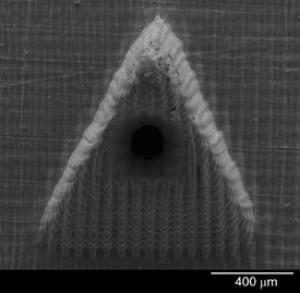December 21, 2012
Last year, a new technology was unveiled that could potentially enable clinicians to detect real-time chemical changes in the body. A proof-of-concept sensor array incorporating three types of sensors would enable the device to measure pH, glucose, and lactate. Such a device could be used to monitor glucose levels in diabetics or the microneedles could be incorporated into sensor arrays that could enable painless patient monitoring of a variety of parameters.
|
A hollow microneedle can be integrated with sensors to detect glucose, lactate, and pH levels. Image from North Carolina State University. |
The microneedle sensors hints at the medical applications to come in the burgeoning field of 3D printing. The technology is poised to play an important role in healthcare in future decades, provided the numbers of materials it can be used with continues to expand and the costs of the 3D printing equipment continues to fall. The manufacturing-related applications are beginning to receive increasing attention in the broader tech industry. Seven companies are expected to exhibit 3D printers at CES 2013.
Roger Narayan, MD, PhD, one of the researchers who helped develop the aforementioned microneedles, specializes in 3D printing technology that is appropriate for creating small-scale devices. While his group previously focused on using microneedles for drug delivery, more recently, the researchers have explored using two-photon polymerization and other 3D printing techniques in order to create microneedles for in situ sensing. "Over the past year, we have spent a lot of time looking at how to integrate sensors for glucose, lactate, and other biologically relevant molecules as well as pH to microneedles so you can essentially put these small-scale painless devices on the skin and try to obtain some kind of real time monitoring of what is going on in the body," Narayan explains. For the microneedles, the researches are using rugged acrylate-based polymers. "Fracture of these devices within the skin is not a concern," Narayan says.
3D printing also can be used not only to create scaffolds for tissue engineering applications ultimately destined for implantation, but also could also be used to create structures used for testing new drugs and investigating treatment modalities on a petri dish. "Our students right now in the lab are working on making various sorts of reproducible structures that could be used for those sorts of petri dish based studies," Narayan says.
|
Roger Narayan speaking about 3D printing at BIOMEDevice in San Jose. Narayan will be speaking on the topic again in February 2013 at MD&M West in Anaheim. His talk is titled "Innovations in additive manufacturing: Transitioning from rapid prototyping to rapid manufacturing." Image by Rick Merritt of EE Times. |
Two-photon polymerization relies on the use of infrared lasers for selective polymerization and hardening of material. One drawback to the technique is that the number of materials types that can be used with it is a number of photosensitive polymers. Other techniques such as selective laser sintering and selective laser melting can be used with metals but "they have limitations in terms of their minimum feature size, which are in the micrometer range," Narayan explains. "You can get some pretty small-scale features in a part that you want to design but you aren't able to go to submicron features."
For medical device companies evaluating 3D printing technologies, a big part of the decision depends on whether your firm wants to use it in-house, Narayan says. Companies willing to outsource 3D printing generally have more options in terms of the types of techniques and the types of input materials that are appropriate. For companies interested in in-house prototyping applications, fused deposition modeling might be an option, he says. It is a popular technology for creating prototypes although the parts that can be produced with the technique have limited mechanical properties and microscale geometries, which makes them difficult to use in functional parts.
Narayan became interested in the field of 3D printing after doing research in laser processing of thin films. "Prior to 2004, most of my interest was using a laser for ablation of materials," he says. "There are thin-film processing techniques out there that rely on ablation of a material in order to create a vapor plume and then deposit on the surface." As it turns out, some of the lasers Narayan used in that research were also applicable for 3D printing.
Brian Buntz is the editor-at-large at UBM Canon's medical group. Follow him on Twitter at @brian_buntz.
Editor's Note: Narayan will be speaking on 3D printing (in the Design & Prototype track) at the upcoming MD&M West trade show and conference.
About the Author(s)
You May Also Like




